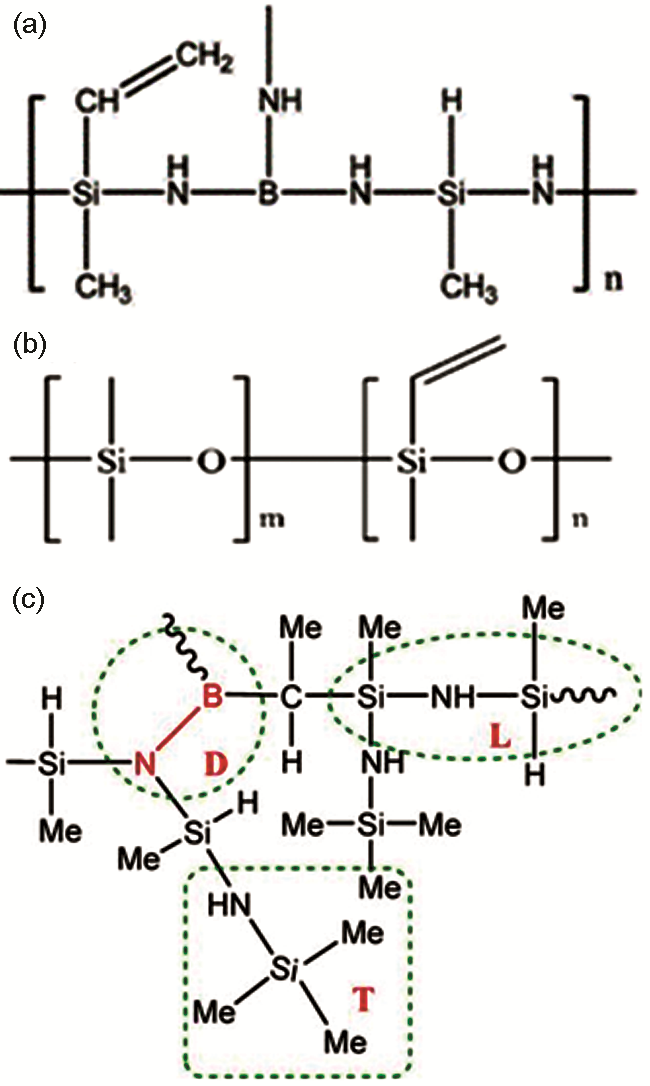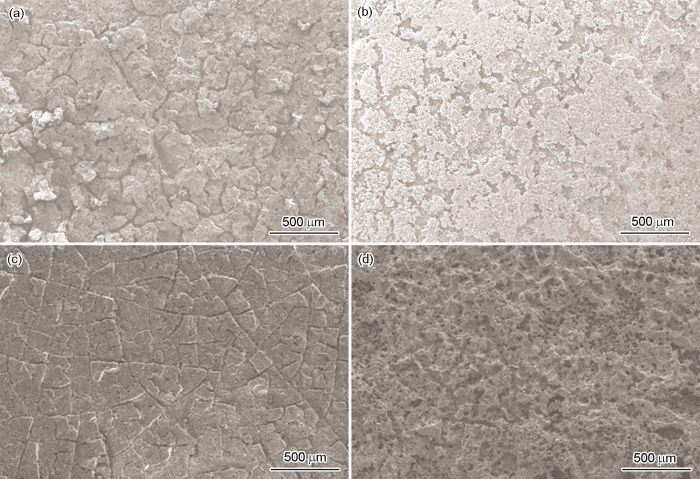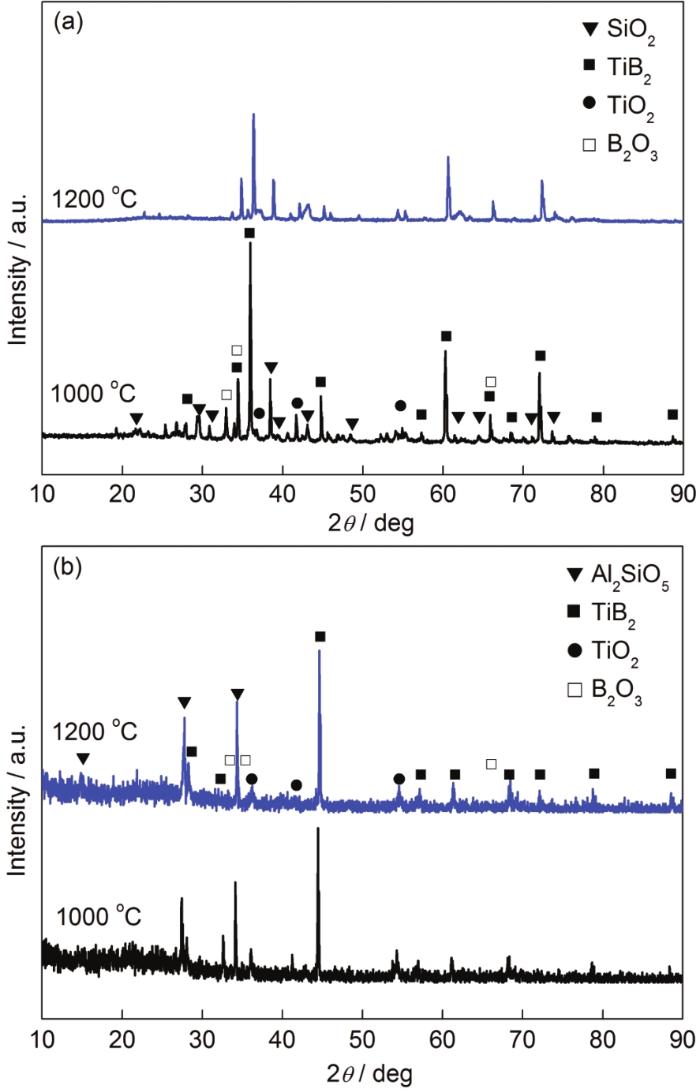本课题组之前的研究[17,18,19,20]表明,粘接试样在高温剪切时是界面处的玻璃相起主要的承载作用;并系统研究了二元SiO2-B2O3以及三元SiO2-B2O3-TiO2和SiO2-B2O3-Al2O3玻璃相对SiBCN陶瓷粘接性能的影响,揭示了其对SiBCN陶瓷的强韧化机理。但是,SiO2-B2O3-TiO2-Al2O3四元玻璃相对SiBCN陶瓷的韧化作用,及纳米Al2O3对SiBCN陶瓷的强化作用还鲜有报道。本实验采用纳米Al2O3,PSO,PBSZ (聚硼硅氮烷) 和TiB2改性的PSNB (聚硅硼氮烷) 粘接剂来连接SiC陶瓷片,并与未添加纳米Al2O3的改性粘接剂 (即PPPT) 的性能进行对比。重点研究了裂解温度和纳米Al2O3对SiBCN基陶瓷高温粘接剂粘接性能的影响。
1 实验方法
1.1 材料与制备
本工作以PSNB为基体树脂,PSO和PBSZ为添加剂,TiB2为活性填料,纳米Al2O3为惰性填料制备改性粘接剂 (标记为PPPTA),其中各组元的质量分数为PSNB∶PSO∶PBSZ∶TiB2∶Al2O3=8∶3∶2∶6∶0.2。作为对照实验,未添加纳米Al2O3的改性粘接剂 (标记为PPPT) 以质量分数比PSNB∶PSO∶PBSZ∶TiB2=8∶3∶2∶6进行配制。
SiC陶瓷片试样尺寸为20 mm×20 mm×2 mm,孔隙率为0.39%。PSNB为浅黄色透明液体,略有刺激性气味,室温下粘度约为2.4 Pa.s,无需交联剂,交联温度约为120 ℃,交联产物为浅黄色固体。PSO为无色无味透明液体,流动性较好。PBSZ作为粘接剂的添加剂,有刺激性气味,不溶于酒精、丙酮,溶于四氢呋喃。PSNB,PSO和PBSZ的分子式如图1所示。TiB2粒度为5 μm,纯度大于99.99%。纳米Al2O3粒径为50 nm,纯度大于99.99%。
图1
首先,将SiC陶瓷片在无水乙醇中超声清洗30 min后烘干备用。然后将配好的改性粘接剂超声分散30 min,在真空皿中抽真空30 min。接着,将粘接剂涂刷到SiC表面,将两个SiC陶瓷片搭接。最后,在烘箱中120 ℃固化2 h,固化压力为9 kPa;然后在箱式炉中1000或1200 ℃裂解2 h。
1.2 测试与表征
采用压缩剪切实验方法来测试粘接试样的粘接强度,测试设备为SANS CMT-4304电子万能实验机。室温 (记为RT) 剪切强度测试条件为:空气中,加载速率0.5 mm/min;高温 (记为HT) 剪切强度测试条件为:空气中800 ℃,升温速率20 ℃/min,到温后保温5 min,加载速率0.582 mm/min。采用扫描电子显微镜 (SEM,S-2700) 观察试样的微观组织和断口形貌。采用X射线衍射仪 (XRD,Rigaku-D/max-2400) 对裂解产物的物相组成进行分析。
2 结果与讨论
2.1 室温与高温粘接强度
图2为PPPT和PPPTA粘接试样经过1000和1200 ℃热处理后的室温和800 ℃下空气中的剪切强度。可见,对于PPPT,当热处理温度从1000 ℃升高到1200 ℃时,室温剪切强度从11.23 MPa下降到2.30 MPa,下降了80%;高温剪切强度从10.4 MPa下降到6.4 MPa,下降了38%。对于PPPTA,当热处理温度从1000 ℃升高到1200 ℃时,其室温剪切强度从15.91 MPa下降到11.80 MPa,下降了26%,分别是PPPT室温剪切强度的1.4和5.1倍;高温剪切强度从12.1 MPa下降到8.5 MPa,下降了30%,分别是PPPT高温剪切强度的1.2和1.3倍。结果表明,添加纳米Al2O3可以显著提高PPPT粘接剂的粘接性能和耐热性能。
图2
图2
PPPT和PPPTA在室温和800 ℃下的粘接强度
Fig.2
Adhesion strengths of PPPT and PPPTA at room temperature and 800 ℃
2.2 粘接试样的微观结构
2.2.1 粘结层截面形貌
图3
图3
PPPT和PPPTA粘接试样在1000 ℃空气中裂解2 h后的截面形貌
Fig.3
Cross-sectional micrographs of the joints of PPPT and PPPTA after pyrolyzed at 1000 ℃ in air for 2 h
2.2.2 室温断口形貌
图4
图4
PPPT和PPPTA粘接试样分别在1000和1200 ℃空气中裂解2 h后接头的室温断口形貌
Fig.4
Room temperature fracture morphologies of PPPT (a, b) and PPPTA (c, d) after pyrolysis at 1000 ℃ (a, c) and 1200 ℃ (b, d) in air for 2 h
2.2.3 高温断口形貌
图5
图5
PPPT和PPPTA粘接试样分别在1000和1200 ℃空气中裂解2 h后接头在800 ℃空气中的断口形貌
Fig.5
High temperature fracture morphologies of PPPT (a, b) and PPPTA (c, d) after pyrolysis at 1000 ℃ (a, c) and 1200 ℃ (b, d) in air for 2 h
2.3 物相分析
图6a为PPPT改性粘接剂在1000和1200 ℃热处理2 h后裂解产物的XRD谱。可见,对于PPPT粘接剂,在空气中1000 ℃裂解2 h后,其成分主要是晶态的TiB2和非晶态的TiO2,SiO2和B2O3玻璃相。当裂解温度上升到1200 ℃,裂解产物仍是TiB2,TiO2,SiO2和B2O3玻璃相,但TiB2的峰强减弱,这是由于其表面氧化包覆TiO2和B2O3玻璃;TiO2,SiO2和B2O3的峰强减弱,这是由于1200 ℃裂解时玻璃相挥发所致。
图6
图6
PPPT和PPPTA在1000和1200 ℃空气中裂解2 h后的XRD谱
Fig.6
XRD patterns of the joints of PPPT (a) and PPPTA (b) after pyrolyzed at 1000 and 1200 ℃ in air for 2 h
图6b为PPPTA改性粘接剂在1000和1200 ℃热处理2 h后裂解产物的XRD谱。可见,随着纳米Al2O3的添加,在空气中1000 ℃裂解2 h后,其成分主要是晶态的TiB2和Al2SiO5及晶化程度较低的TiO2和B2O3玻璃相。当裂解温度上升到1200 ℃,裂解产物仍是TiB2,Al2SiO5,TiO2和B2O3玻璃相,但Al2SiO5的峰强增强,说明莫来石相的晶化程度进一步提高,易产生内应力,从而降低粘接性能。
2.4 讨论
基于微结构分析,PPPT粘接试样的室温和高温断面凹凸不平,断口发生在粘接层中;PPPTA粘接试样的室温和高温断面基本平整,试样从界面处断裂,说明纳米Al2O3的添加使得界面处玻璃相 (O2在界面处富集) 的强度高于粘接层SiBCN的内聚强度。而且,PPPTA不同温度裂解后的粘接性能要优于PPPT的,究其原因:一方面,莫来石相的形成,有助于SiO2-B2O3-TiO2-Al2O3四元玻璃相的形成,从而有效提高玻璃相的耐热性,高温时抑制玻璃相的挥发,增强了界面的承载能力;另一方面,纳米Al2O3分布于SiBCN粘接层中,起到颗粒增强的作用,有效提高粘接层的内聚强度。纳米Al2O3增强SiBCN陶瓷的示意图见图7。
图7
图7
纳米Al2O3增强SiBCN陶瓷的示意图
Fig.7
Schematic illustration of nano-Al2O3 reinforced SiBCN ceramic
3 结论
添加纳米Al2O3对SiBCN的强韧化作用使得PPPTA的粘接性能优于PPPT的,主要原因:(1) 纳米Al2O3分布于SiBCN陶瓷粘接层中,发挥颗粒增强的作用,有利于提高粘接层的内聚强度;(2) 纳米Al2O3和SiO2反应生成莫来石,有效抑制高温时玻璃相的挥发,有利于提高粘接界面处的界面强度。
参考文献
Application status of SiC ceramics
[J].
碳化硅陶瓷的应用现状
[J].
Development and application of silicon carbide cerandcs
[J].
碳化硅陶瓷的发展与应用
[J].
The application and performance for SiC-ceramics
[J].
碳化硅陶瓷的性能与应用
[J].
Application of SiC ceramics to manufacture of spacecraft combustion chamber
[J].
SiC陶瓷在航天器高温结构件研制中的应用
[J].
Progress and application of carbon fibers reinforced silicon carbide ceramic matrix composites
[J].
碳纤维增强碳化硅陶瓷基复合材料的研究进展及应用
[J].
Research and development of porous silicon carbide ceramics
[J].
多孔SiC陶瓷的研究进展
[J].
Progress in research work of new CMC-SiC
[J].
新型碳化硅陶瓷基复合材料的研究进展
[J].
The research between iron fibre-oxide and properties relationship in composite material
[D].
复合材料中铁纤维的氧化与性能的关系研究
[D].
Joining of ZrO2/Al2O3 ceramics by SiC oxidizing method
[D].
ZrO2-Al2O3陶瓷的SiC氧化法连接
[D].
Brazing process and mechanism of ZrB2-SiC composite ceramic using Zr-Ni-based filler
[D].
Zr-Ni基钎料钎焊ZrB2-SiC复合陶瓷的连接工艺及机理研究
[D].
Study on the connection of ceramic membrane tube with metal material
[D].
陶瓷膜管与金属材料连接的研究
[D].
Study on microwave joining of ZTM ceramics/fiber braids and its elastic behaviour
[D].
ZTM陶瓷/纤维编织体微波连接及其弹性行为研究
[D].
Polymer‐derived ceramics: 40 years of research and innovation in advanced ceramics
[J].
Joining of SiC to SiC using polyborosiloxane
[J].
Structure and composition of interlayers in joints between SiC bodies
[J].
Joining of reaction-bonded silicon carbide using a preceramic polymer
[J].
A novel high temperature adhesive for bonding Al2O3 ceramic
[J].
An air stable high temperature adhesive from modified SiBCN precursor synthesized via polymer-derived-ceramic route
[J].
The improvement in thermal and mechanical properties of TiB2 modified adhesive through the polymer-derived-ceramic route
[J].
Effect of PSO and TiB2 content on the high temperature adhesion strength of SiBCNO ceramic
[J].
Research on preparation and performances of modified high-temperature adhesive
[D].
改性耐高温粘接剂的制备与性能研究
[D].











